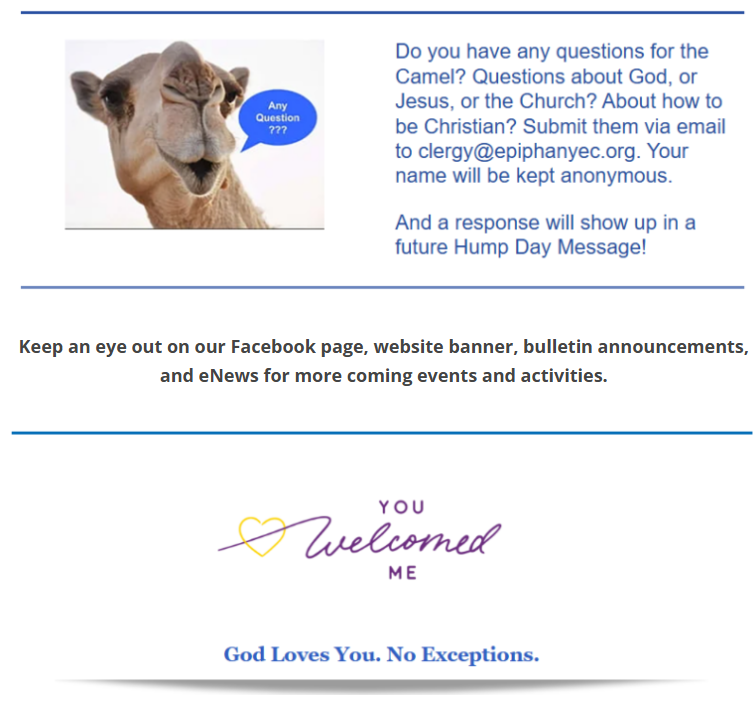
January 29, 2025
| Translations of the Bible by parishioner Dick Fichter with assistance from Rev. Dina |
The Geneva Bible
When I was looking into translations of psalms, I came across the Breeches Bible. This stopped me in my tracks. What is the breeches Bible all about?Officially known as the Geneva Bible, this translation is referred to as the Breeches Bible because, according to Genesis 3:7, Adam and Eve sewed fig leaves together to make “breeches.” I had never heard of breeches being made from fig leaves before as part of Adam and Eve’s wardrobe, but I knew fig leaves were involved. I better see what my Bible says about this.
My Bible is the New Oxford Annotated Bible, 1991, of the new revised standard version, which states that instead of breeches, “…they sewed fig leaves together and made loincloths for themselves…, which to me is a single piece of cloth wrapped around the hips. This Bible was a gift from my son who has given me several religious books over the years for which I thanked him at the time and promptly shelved them. Only recently have I appreciated their true value by spending enough time with them. They provide me with greater insight both religiously and historically into the Bible and Christianity. Especially with respect to the integral relationship between societal and religious changes.
One of the books is the Layman’s Parallel Bible which has four columns of each line of a different translation of the Bible. These include
- The King James,
- Modern Language,
- Living Bible and
- Revised Standard.
The following are the four translations of Gensis 3:7 from the Parallel Bible.
King James: And the eyes of them both were opened, and they knew that they were naked; and they sewed fig leaves together and made themselves aprons.
Modern Language: Then the eyes of both were opened and they realized that they were naked. So, they sewed fig leaves together and made themselves skirts.
Living Bible: And as they ate it, suddenly they became aware of their nakedness, and were embarrassed. So, they strung fig leaves together to cover themselves around the hips.
Revised Standard: Then the eyes of both were opened, and they knew that they were naked, and they sewed fig leaves together and made themselves aprons.
The fig leaves were formed into aprons, skirts and something to cover themselves around the hips which included a loincloth in the new revised version. These parallel passages convey basically the same message to me, but the choice of words convey slightly different meanings which lead to different understandings. An apron covers only one side and conveys an idea distinctly different from breeches. This led me to consider how many different versions of the Bible are there?
An Internet search reveals there are over 3,142 bible versions. How many versions does the (English language) Bible have?
Since Tyndale’s English translation in 1526, translators and publishers have created approximately 900 different English Bibles, making it hard to know which to choose and which is the most accurate. This naturally led me to the Episcopal glossary for approved Bible translations.

Bibles authorized by the Episcopal Church
The translations of the Bible authorized for use in the worship of the Episcopal Church are the King James (Authorized Version), together with the Marginal Readings authorized for use by the General Convention of 1901, the English Revision of 1881, the American Revision of 1901, the Revised Standard Version of 1952, the Jerusalem Bible of 1966, the New English Bible with the Apocrypha of 1970, the 1976 Good News Bible (Today’s English Version), the New American Bible (1970), the Revised Standard Version, an Ecumenical Edition, known as the “R.S.V. Common Bible” (1973), the New International Version (1978), the New Jerusalem Bible (1987), the Revised English Bible (1989), and the New Revised Standard Version Bible (1990). See Apocrypha.
Update: The 80th General Convention passed resolution 2022-A144 amending the approved translations to include the Contemporary English Version (1995), the Contemporary English Version Global (2005), the Common English Bible (2011), The Revised New Jerusalem Bible (2019), and the New Revised Standard Version (2022).
Next time, what is the New Revised Standard Bible.



